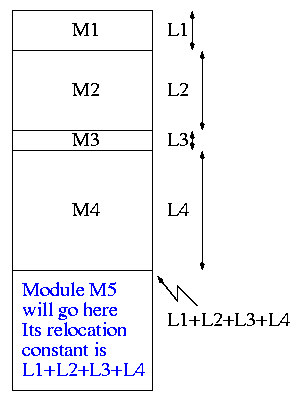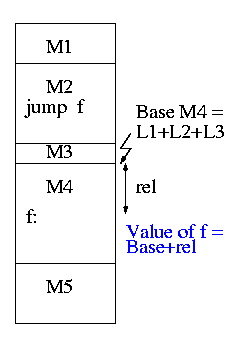Operating System
================ Start Lecture #1 ================
Operating Systems
2002-2003 Fall
Monday 5-6:50
Ciww 109
Chapter -1: Administrivia
I start at -1 so that when we get to chapter 1, the numbering will
agree with the text.
(-1).1: Contact Information
- gottlieb@nyu.edu (best method)
- http://allan.ultra.nyu.edu/~gottlieb two el's in allan
- 715 Broadway, Room 712
(-1).2: Course Web Page
There is a web site for the course. You can find it from my home
page, which is http://allan.ultra.nyu.edu/~gottlieb
- You can find these lecture notes on the course home page.
Please let me know if you can't find it.
- I mirror my home page on the CS web site.
- I also mirror the course pages on the CS web site.
- But, the official site is allan.ultra.nyu.edu.
It is the one I personally manage.
- The notes will be updated as bugs are found.
- I will also produce a separate page for each lecture after the
lecture is given. These individual pages
might not get updated as quickly as the large page
(-1).3: Textbook
The course text is Tanenbaum, "Modern Operating Systems", 2nd Edition
- The first edition is not adequate as there have been many
changes.
- Available in bookstore.
- We will cover nearly all of the first 6 chapters.
(-1).4: Computer Accounts and Mailman Mailing List
- You are entitled to a computer account, please get it asap.
- Sign up for the Mailman mailing list for the course.
http://www.cs.nyu.edu/mailman/listinfo/G22_2250_001_fa02
- If you want to send mail just to me, use gottlieb@nyu.edu not
the mailing list.
- Questions on the labs should go to the mailing list.
You may answer questions posed on the list as well.
- I will respond to all questions; if another student has answered the
question before I get to it, I will confirm if the answer given is
correct.
(-1).5: Grades
Assuming 3 labs, which is likely, grades will computed as
.3*LabAverage + .7*FinalExam (but see homeworks below).
(-1).6: No Midterm Exam
(-1).7: Homeworks and Labs
I make a distinction between homeworks and labs.
Labs are
- Required.
- Due several lectures later (date given on assignment).
- Graded and form part of your final grade.
- Penalized for lateness.
- Computer programs you must write.
Homeworks are
- Optional.
- Due the beginning of Next lecture.
- Not accepted late.
- Mostly from the book.
- Collected and returned.
- Able to help, but not hurt, your grade.
(-1).7.1: Doing Labs on non-NYU Systems
You may solve lab assignments on any system you wish, but ...
- You are responsible for any non-nyu machine.
I extend deadlines if the nyu machines are down, not if yours are.
- Be sure to upload your assignments to the
nyu systems.
- In an ideal world, a program written in a high level language
like Java, C, or C++ that works on your system would also work
on the NYU system used by the grader.
Sadly this ideal is not always achieved despite marketing
claims that it is achieved.
So, although you may develop you lab on any system,
you must ensure that it runs on the nyu system assigned to the
course.
- If somehow your assignment is misplaced by me and/or a grader,
we need a to have a copy ON AN NYU SYSTEM
that can be used to verify the date the lab was completed.
- When you complete a lab (and have it on an nyu system), do
not edit those files. Indeed, put the lab in a separate
directory and keep out of the directory. You do not want to
alter the dates.
(-1).7.2: Obtaining Help with the Labs
Good methods for obtaining help include
- Asking me during office hours (see web page for my hours).
- Asking the mailing list.
- Asking another student, but ...
Your lab must be your own.
That is, each student must submit a unique lab.
Naturally changing comments, variable names, etc does
not produce a unique lab
(-1).8: The Upper Left Board
I use the upper left board for lab/homework assignments and
announcements. I should never erase that board.
Viewed as a file it is group readable (the group is those in the
room), appendable by just me, and (re-)writable by no one.
If you see me start to erase an announcement, let me know.
(-1).9: A Grade of ``Incomplete''
It is university policy that a student's request for an incomplete
be granted only in exceptional circumstances and only if applied for
in advance. Naturally, the application must be before the final exam.
Chapter 0: Interlude on Linkers
Originally called a linkage editor by IBM.
A linker is an example of a utility program included with an
operating system distribution. Like a compiler, the linker is not
part of the operating system per se, i.e. it does not run in supervisor mode.
Unlike a compiler it is OS dependent (what object/load file format is
used) and is not (normally) language dependent.
0.1: What does a Linker Do?
Link of course.
When the compiler and assembler have finished processing a module,
they produce an object module
that is almost runnable.
There are two remaining tasks to be accomplished for the object module
to be runnable.
Both are involved with linking (that word, again) together multiple
object modules.
The tasks are relocating relative addresses
and resolving external references.

0.1.1: Relocating Relative Addresses
- Each module is (mistakenly) treated as if it will be loaded at
location zero.
- For example, the machine instruction
jump 100
is used to indicate a jump to location 100 of
the current module.
- To convert this relative address to an
absolute address,
the linker adds the base address of the module
to the relative address.
The base address is the address at which
this module will be loaded.
- Example: Module A is to be loaded starting at location 2300 and
contains the instruction
jump 120
The linker changes this instruction to
jump 2420
- How does the linker know that Module M5 is to be loaded starting at
location 2300?
- It processes the modules one at a time. The first module is
to be loaded at location zero.
So relocating is trivial
(adding zero).
We say that the relocation constant is zero.
- After processing the first module, the linker knows its length
(say that length is L1).
- Hence the next module is to be loaded starting at L1, i.e.,
the relocation constant is L1.
- In general the linker keeps the sum of the lengths of
all the modules it has already processed; this sum is the
relocation constant for the next module.

0.1.2: Resolving External Reverences
- If a C (or Java, or Pascal) program contains a function call
f(x)
to a function f() that is compiled separately, the resulting
object module must contain some kind of jump to the beginning of
f.
- But this is impossible!
- When the C program is compiled. the compiler and assembler
do not know the location of f() so there is no
way they can supply the starting address.
- Instead a dummy address is supplied and a notation made that
this address needs to be filled in with the location of
f(). This is called a use of
f.
- The object module containing the definition
of f() contains a notation
that f is being defined and gives the relative address of the
definition, which the linker can convert to an absolute address.
- The linker then changes all uses of f() to the correct absolute address.
The output of a linker is called a load module
because it is now ready to be loaded and run.
To see how a linker works lets consider the following example,
which is the first dataset from lab #1. The description in lab1 is
more detailed.
The target machine is word addressable and has a memory of 250
words, each consisting of 4 decimal digits. The first (leftmost)
digit is the opcode and the remaining three digits form an address.
Each object module contains three parts, a definition list, the
program text itself, and a use list. Each definition is a pair (sym,
loc). Each use is a symbol.
The program text consists of a count N followed by N pairs (type, word),
where word is a 4-digit instruction described above and type is a
single character indicating if the address in the word is
Immediate,
Absolute,
Relative, or
External.
Input set #1
1 xy 2
2 z xy
5 R 1004 I 5678 E 2000 R 8002 E 7001
0
1 z
6 R 8001 E 1000 E 1000 E 3000 R 1002 A 1010
0
1 z
2 R 5001 E 4000
1 z 2
2 xy z
3 A 8000 E 1001 E 2000
The first pass simply finds the base address of each module and
produces the symbol table giving the values for xy and z (2 and 15
respectively). The second pass does the real work using the symbol
table and base addresses produced in pass one.
Symbol Table
xy=2
z=15
Memory Map
+0
0: R 1004 1004+0 = 1004
1: I 5678 5678
2: xy: E 2000 ->z 2015
3: R 8002 8002+0 = 8002
4: E 7001 ->xy 7002
+5
0 R 8001 8001+5 = 8006
1 E 1000 ->z 1015
2 E 1000 ->z 1015
3 E 3000 ->z 3015
4 R 1002 1002+5 = 1007
5 A 1010 1010
+11
0 R 5001 5001+11= 5012
1 E 4000 ->z 4015
+13
0 A 8000 8000
1 E 1001 ->z 1015
2 z: E 2000 ->xy 2002
(Unofficial) Remark:
It is faster (less I/O) to do a one pass approach, but is harder
since you need ``fix-up code'' whenever a use occurs in a module that
precedes the module with the definition.
The linker on unix is mistakenly called ld (for loader), which is
unfortunate since it links but does not load.
Lab #1:
Implement a linker. The specific assignment is detailed on the sheet
handed out in in class and is due in three weeks. The
content of the handout is available on the web as well (see the class
home page).
End of Interlude on Linkers
Chapter 1: Introduction
Homework: Read Chapter 1 (Introduction)
Levels of abstraction (virtual machines)
- Software (and hardware, but that is not this course) is often
implemented in layers.
- The higher layers use the facilities provided by lower layers.
- Alternatively said, the upper layers are written using a more
powerful and more abstract virtual machine than the lower layers.
- Alternatively said, each layer is written as though it runs on the
virtual machine supplied by the lower layer and in turn provides a more
abstract (pleasant) virtual machine for the higher layer to run on.
- Using a broad brush, the layers are.
- Applications and utilities
- Compilers, Editors, Command Interpreter (shell, DOS prompt)
- Libraries
- The OS proper (the kernel, runs in
privileged/kernel/supervisor mode)
- Hardware
- Compilers, editors, shell, loader. etc run in user mode.
- The kernel itself is itself normally layered, e.g.
- ...
- Filesystems
- Machine independent I/O
- Machine dependent device drivers
- The machine independent I/O part is written assuming ``virtual
(i.e. idealized) hardware''. For example, the machine independent I/O
portion simply reads a block from a ``disk''. But
in reality one must deal with the specific disk controller.
- Often the machine independent part is more than one layer.
- The term OS is not well defined. Is it just the kernel? How
about the libraries? The utilities? All these are certainly
system software but not clear how much is part of the OS.


